Product Hub March 30, 2015
Design Gone Digital
Epson brings sublimation to the catwalks of New York Fashion Week
Epson wants to do for fashion what it once helped to do for photography: ushering the craft into a new digital age. The manufacturer of printers and other technology showcased its Digital Couture Project during a pre-Fashion Week party in Manhattan's West Village in February. Featuring mini-collections from 11 up-and-coming designers from across the Western hemisphere, the event attracted a well-heeled crowd – and a few minor celebrities like actresses Analeigh Tipton and Lilla Crawford – to a spacious concrete-floored studio to sip cocktails, rejuvenate with vitamin-infused IV drips and view the latest in sublimated style: from dreamy, flowing gowns to high-concept, zipper-heavy unisex looks.
The event marks a major push into the fashion world for Epson, according to Mark Radogna, an executive in the company's commercial imaging group. "Polyester is actually a very big part of the fashion industry," Radogna says. Sublimation inkjet printers, like Epson's, use special dyes and transfer papers, which are heat-pressed onto polyester garments, bonding to the manmade fibers for color-rich designs that don't flake or fade. "Fashion designers are able to see their vision right away, going from concept to cut and sew in the same day," Radogna adds. "We're hoping to bring short-run, high-end fashion production back to the U.S. The technology is so easy now."
Upon entering the fashion show, guests walked up a long, sloped corridor, the halls dancing with multicolored lights, courtesy of the company's LCD projectors. A handful of technicians behind glass cages demonstrated the capabilities of Epson's SureColor F-Series dye sublimation printers. A large sheet of heat-transfer paper, covered in rows of rainbow-hued roses, unfurled from one of the machines.
According to Radogna, Epson "sells more digital and dye sublimation printers for fashion than any other brand." He adds: "It's really cool to see what people are doing with the technology."
The designers featured at Epson's show raved about the possibilities afforded by sublimation technology. Here's a look at some of the designers and standout pieces at the show.
Theresa Hegel is a senior staff writer for Wearables. Contact her at cmittica@asicentral.com and follow her on Twitter at @TheresaHegel.
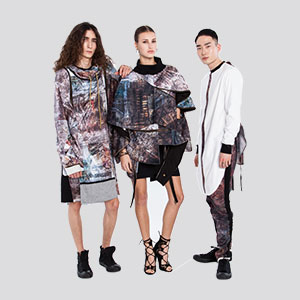
Mariana Morrell of Brazil says she was inspired by the "aesthetics of the New York ghetto" when she created her convertible, unisex garments featuring various cityscape prints in a muted color palette. Just as the sublimation printer was easy to use, Morrell's pieces are meant to be "very easy to wear," she says. Covered in snaps and zippers, the collection included pants that could be flipped upside down into sweaters, jackets that morphed into backpacks and scarves and other changeable creations.
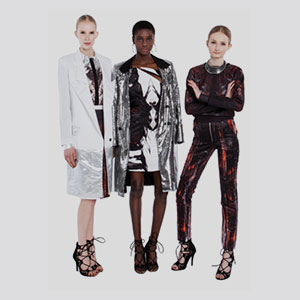
Moah Saldaña, a 22-year-old designer from Peru, took a cue from "cyber punk" for his looks, pairing silver accents – like a show-stopping sequined jacket – with sublimated separates in various combinations of red, black and white. The Epson show was the first time the young designer had dabbled in dye sublimation, and he says he liked how much time the technology saved him.
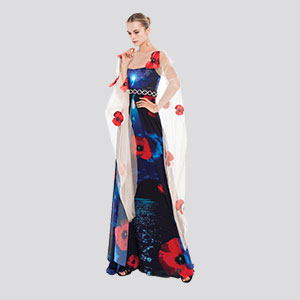
Chilean designer Marco Antonio Farias says sublimation freed him to indulge in passing inspirations rather than stick to a rigid theme. "It was chaotic in a way," he says through a translator. "I was able to translate my emotions with sublimation." His collection included a flowing blue gown dotted with large poppies, its trailing, gauzy sleeves also decorated with appliqués of the red flower – inspired by the idea of a "Chinese empress."
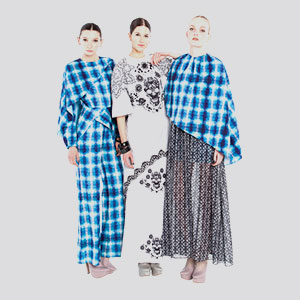
Maggie Barry, a Los Angeles designer who has created custom pieces for celebrities such as Lady Gaga and Naomi Campbell, loves the modern look and versatility of polyester fabrics and the soft hand of the sublimated prints. "It's really the future," she says. Barry married fashion and function in her "Space Tribe" collection, her standout piece a high-necked, full-skirted black dress, splashed with a bright orange, yellow and blue soundwave-like spattern.
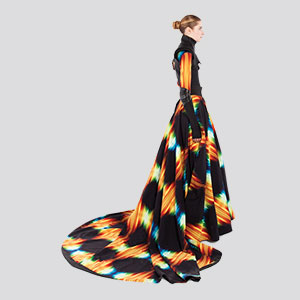
Venezuelan-born Leonor Silva, who studied in Paris and has worked for Hugo Boss and Carolina Herrera, delighted in the precision of Epson's sublimation printers. Among her three looks was a black trompe l'oeil print, mimicking the intricate look of lace on a stiff, white dress. She "made it edgy" by giving the faux-lace a skull and flower motif.

Product Hub
Find the latest in quality products, must-know trends and fresh ideas for upcoming end-buyer campaigns.
